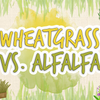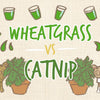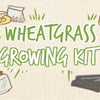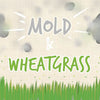Wheatgrass Vs. Wheat: The Comparative Guide
Wheat and wheatgrass might as well be two sides of the same coin as it takes one to grow the other. The differences arise when it comes to their nutritional value whereby the sprouting process gives wheatgrass an upper hand over dry wheat seeds. This comparative guide focuses on the differences between wheat and wheatgrass in terms of health benefits, growing differences, and the associated risks of consuming wheat and wheatgrass, among others.
Not Much Time? Skip To What You'd Like To Learn...
-
What Is Wheatgrass?
-
What Is Wheat?
-
5 Differences Between Wheatgrass And Wheat
-
Wheat, Wheatgrass, And Celiac Disease
-
Growing Differences
-
How To Consume
-
Where To Buy From
-
History Of Wheat And Wheatgrass
-
Risks Associated With Consuming Wheat And Wheatgrass
-
What Is High-Risk Food?
-
Common Questions
What Is Wheatgrass?
Wheatgrass is the sprout, or rather the very first young leaves that grow from the wheat plant, also known as Triticum aestivum. They are used as food, or dietary supplements in the form of powder and can be served either raw in the form of wheatgrass shots, shakes and juice or freeze-dried. Health experts have applauded wheatgrass mainly because of its nutritional benefits for human consumption. For More Information On Wheatgrass Checkout healthline.com.
What Is Wheat?
Wheat is a crop belonging to the grass family that's cultivated for its cereal grains whose flour is used in everyday baked products like bread and bagels. Wheat’s popularity spans over ten thousand years and is one of the earliest crops to have been grown. This popularity can be attributed to its nutritional value and its taste and scent notes. Although wheat products are widely consumed around the world, health experts advise that it should be less consumed because of the health risks that are associated with its consumption. For More Information On Wheat Checkout healthline.com.
5 Differences Between Wheatgrass And Wheat

Although wheatgrass is obtained by sprouting wheat grains, it does defer from wheat grains in terms of gluten content, taste, and preparation method.
Gluten Content
Gluten is a class of proteins that occur naturally in cereal grains such as wheat. Gluten is the reason why wheat dough is sticky, it also makes wheat products chewy. In wheat, gluten accounts for 80% of all protein. Unfortunately gluten can trigger allergic reactions (gluten intolerance) and digestive discomfort.
Wheatgrass & Gluten
Gluten-free wheatgrass can be obtained by harvesting the grass before maturity and production of seeds. This is due to the fact that sprouting leads to a breakdown of gluten into amino acids which are readily absorbed during digestion.
Wheat & Gluten
Wheat has a considerable amount of gluten with a 100g of whole wheat flour containing up to 13g of gluten.
How Long To Grow
Wheatgrass & Time To Grow
Wheatgrass seeds take as little as 2 days to sprout in trays or pots. The grass then takes between 6 and 10 days to grow to harvest size. Cultural conditions can, however, alter the average time for growing wheatgrass. Insufficient sunlight or water may slow down the growth rate of wheatgrass or even hinder the development of its usual green and rich color.
Wheat & Time To Grow
Wheat takes about 7 or 8 months to mature and is mostly planted in the fall, often between October and December. Upon the end of this period, the planted wheat reaches its maturity hence creating a pretty golden contrast, especially in spring gardens. Over the winter, the wheat grows to be harvested either during the spring or early summer.
Consumption Differences
Wheatgrass - Eating
Wheatgrass can be consumed in the form of fresh wheatgrass juice, wheatgrass supplements in capsule or pill form, wheatgrass shots, or in the form of wheatgrass juice powder.
Wheat - Eating
Whole and white-wheat flour are among the primary ingredients used in different baked foods, for example, bread. Additionally, wheat can be used in other food products such as noodles, pasta, bulgur, semolina, and couscous.
Where They Grow
Wheatgrass - Growing Location
Wheatgrass usually grows best indoors or outdoors in moderate climatic conditions, wheatgrass grows optimally within 70-80 F range and indirect sunlight.
Wheat - Growing Location
Most of the wheat consumed in the whole world is grown in the temperate areas located in the Northern hemisphere. Spring wheat is mainly grown during mild winters in India, Pakistan, Africa, Mexico, Australia, and America.
The planting of winter wheat usually occurs in the Northern hemisphere from September to November. They are then harvested during early autumn or in the summer of the following year. In some places around the world, Chile for example, winter wheat crop takes a year to be fully mature for harvest. It has also been established that winter wheat yields more as compared to spring wheat.
Taste Differences
Wheatgrass - Taste
. Wheatgrass juice has a strong taste that leaves behind an earthy aftertaste, often described by other people as a raw yet pungent taste. Also, the wheatgrass shot has a bitter taste, which requires covering with other sweet fruits.
Wheat - Taste
Wheat has a good texture and a pure wheat flavor. Whole wheat bread, for example, has a sweet, nutty wheat flavor and a soft doughy texture.
Which Is Healthier?
Nutrients In Wheat
-
Carbs - one cup of white, or all-purpose wheat flour has 95 grams of carbs. The total content of carbohydrates in wheat includes all the three types such as starches,
-
Fiber - fiber content accounts for 12 to15 % of the total dry weight.
-
Protein - proteins account for 7-22 percent of the dry weight of wheat.
-
Manganese - There is 4.067 milligrams of manganese in a serving size of 100 grams of wheat. This represents a percentage daily value of 177 percent. Manganese plays an essential role in the regulation of body functions such as metabolism of cholesterol, amino acids, carbohydrates, and glucose. Manganese is also essential in blood clotting, bone formation, and in reducing inflammation.
-
Selenium - 100 grams of wheat contains 61.8 microgram (mcg) selenium, representing 112% of daily value (DV). Selenium helps the body to function properly. It also aids thyroid and metabolism function and protects the body from damages that are triggered by oxidative stress.
-
Phosphorus - 100 grams of wheat contains 357 mg of phosphorus in, representing 51 percent of daily value. Phosphorus plays a major function in the formation of teeth and bones, is essential in controlling how fats and carbohydrates are utilized by the body, and it also helps the body to produce protein used in maintenance, growth, and the repair of tissues and cells.
-
Copper - 100 grams of wheat contains 410 mg of copper, which represents 46 percent of daily value. Copper helps in maintaining nerve cells, making red blood cells, and maintaining the immune system. It also helps the body in the formation of iron, the formation of collagen, and is essential in the production of energy.
-
Folate - 100 grams of wheat contains 44.00 mcg of folate, also known as vitamin B9. Folate aids in the formation of red blood cells, hence facilitating the prevention of anemia.
Nutrients In Wheatgrass
1 oz of wheatgrass, the nutrients are distributed in the following quantities and percentages;
-
Carbs 0.5g
-
Protein 0.3g
-
Vitamin C (200 mg)
-
Vitamin E (9143 mg)
-
Vitamin K (1000 mg)
-
Vitamins B6 (1114 mg)
-
Vitamins B12 (1.4 mg)
-
Calcium (429 mg)
-
Iron (229 mg)
-
Magnesium (111 miligrams)
-
Phosphorus (400 mg)
-
Copper (48.6 miligrams)
-
Zinc (1771 mg)
Note: Although wheat and wheatgrass contain all the essential nutrients that are required by the body, wheatgrass is healthier because it is gluten-free.
Wheat, Wheatgrass, And Celiac Disease
Gluten found in wheat causes an immune reaction called celiac disease. For people with celiac disease, eating gluten activates an immune response that occurs in the small intestines.
What Is Celiac Disease?
Celiac disease is defined as a severe autoimmune illness that affects genetically predisposed people. Gluten ingestion in such people causes damage in the small intestine. This illness is hereditary and can develop irrespective of age in populations where people start taking medicines or eating foods containing gluten.
Can You Eat Wheat Or Wheatgrass When Suffering From Celiac Disease?
It is not advisable for people with gluten intolerance to eat wheat because the gluten content in wheat may cause severe damages to the small intestine walls. However, wheatgrass obtained from a growing seedless wheat plant can be eaten by people who have celiac disease because it is gluten-free.
Growing Differences
How To Grow Wheatgrass
Growing wheatgrass incorporates two main processes, namely soaking and planting the seeds.
1. Soaking And Germinating Wheatgrass Seeds
The first part of the process entails the sourcing of the seeds, preparing the seeds for soaking, and eventually soaking the seeds.
2. Planting The Seeds
The second part of the planting process involves preparing the seed tray for planting, planting the seeds, keeping the seeds moist, and ensuring that the grass is partially placed in sunlight.
How To Grow Wheat
As opposed to growing wheatgrass, growing wheat incorporates three main processes.
1. Crop Planning
The first process is the planning of your crop and further includes other steps. These steps involve determining how much space is available, determining the preferable type of wheat to plant (spring and winter wheat), choosing the appropriate location for planting, and timing the season for planting.
2. Planting The Seeds
The second process is the planting of the seeds and also entails other steps. These steps include tilling your land, spreading of compost (if necessary), spreading the seeds, raking the seeds, using a thin layer of soil to cover the seeds, and watering the newly planted seeds.
3. Maintenance
The third and final step is the maintenance of your wheat and also entails other steps. These processes include watering the wheat plants during dry spells, weeding as required, and protecting the wheat plants from pests.
Conclusion
Growing wheatgrass is both easier and cheaper as compared to growing wheat. This is because of the simple two-steps involved in growing wheatgrass because it requires little labor and financial expenses to sprout and plant. On the other hand, the three processes of growing wheat include a lot of labor and financial costs from planning your crops, planting the seeds, and maintaining your wheat.
How To Consume

Wheatgrass
-
Juice - Wheatgrass juice has been widely accepted and consumed as a health drink. Drinking fresh wheatgrass juice immediately after preparation and on an empty stomach is associated with numerous health benefits.
-
Smoothies - The most recommended ways of incorporating wheatgrass in smoothies is by extracting the juice and using it as a liquid base or using wheatgrass powder in your smoothies.
-
Shots - Just like the juice, wheatgrass shots should be taken fresh within around 15 minutes after juicing. The shots should be taken undiluted and also preferably on an empty stomach to increase the absorption of the nutrients into the body.
Wheat
-
Bread - Whole-wheat bread is considered to be healthier because the germ and the bran contain vitamins and fiber that helps to boost the immune system and to improve the digestive health, respectively.
-
Cakes - Whole wheat flour is recommended for making cakes because it is light. The flour adds more nutrition in cakes and also provides a tasty and nutty flavor.
-
Noodles - Wheat noodles are parked with essential nutrients that help to boost the immune system.
Where To Buy From
Wheatgrass
Amazon is the most recommended place to buy wheatgrass products such as organic wheatgrass superfood (raw juice powder), wheatgrass powder, organic wheatgrass smoothies, and wheatgrass shots, among others.
Wheatgrass Powder
Product: Organic Wheatgrass Powder

Price: $1.33 per ounce
Brand: Sari Foods Company
[Check The Latest Price Here]
Sari Foods Company was founded in 2012 with a mission to bring the essence of food to its customers. The company believes that when nutrients are sourced from food, the human bodies can flourish as nature envisioned. Sari Foods Company preserves all the fiber obtained from the leaves when making their wheatgrass powder. By so doing, the consumers feel fuller for longer.
Whole Wheat Seeds

Product: Chemical Free Hard Red Wheat Seed
Price: $32.98 for 5 Lbs
Brand: Scotts.
[Check The Latest Price Here]
The Scotts Miracle-Gro Company is a multinational corporation with its headquarter in Marysville, Ohio, in the United States. The company produces, distributes, and sells consumer lawn, pest control, and garden products, including whole wheat seeds such as chemical free hard red wheat seed.
History Of Wheat And Wheatgrass
Wheat's History - The growing and cultivation of wheat began around 10, 000 years ago with an origin that traces back to the southeastern part of Turkey.
Wheatgrass' History - Wheatgrass is believed to be more than 5000 years old. This dates back to a time when Egyptians supposedly believed that young wheat shoots were sacred and would gladly eat them for the encouraging effects; they had both on their vitality and health. Also, Indians used wheatgrass for thousands of years as part of their Ayurvedic medicine, whose primary goal is to encourage good health as opposed to fighting disease.
Risks Associated With Consuming Wheat And Wheatgrass
Wheat - The gluten present on wheat can cause adverse side effects in individuals who are gluten intolerant. Other conditions that may necessitate the reduction of gluten in a diet include wheat allergy and dermatitis herpetiformis (DH)-a skin rash that is caused by eating gluten.
Wheatgrass - Wheatgrass, as opposed to wheat, is usually considered to be safe, except that it may cause constipation, anorexia, and nausea. However, health experts advise that people who are allergic to grass, or wheat, or have a gluten intolerance, or have celiac disease should seek the advice of a doctor before they use wheatgrass products.
What Is High-Risk Food?
High-risk foods refers to foodstuffs that can be easily contaminated by bacteria hence may cause diseases. The diseases caused by bacteria vary in duration and cause and may include campylobacter, salmonella, listeria, Escherichia coli (E Coli) 0157, and clostridium perfringens, among others.
Is Wheat Or Wheatgrass High Risk?
The gluten present in wheat makes it a high-risk food as compared to wheatgrass that is generally considered to be safe and gluten-free. However, people who are allergic to wheat are also advised to avoid wheatgrass entirely.
What Are The Risks Of Wheat And Wheatgrass?
The risks associated with wheat are related to the gluten present in wheat. These risks range from mild effects such as bloating, fatigue, diarrhea, and alternating constipation to severe consequences such as malnutrition (probably caused by anorexia), unintentional loss of weight, and intestinal damage.
Common Questions
What Are Wheat Berries?
Wheat berries are defined as the palatable parts of the wheat kernel, such as the endosperm, the germ, and the bran before the grain is processed. The color of wheat berries is between a tan and a reddish-brown. They are available either as a soft or a hard-processed grain.
What Are Wheat Germs?
Wheat germ is described as the part of the wheat kernel that is accountable for enabling wheat plants to replicate and grow new shoots. It is the embryo or the nucleus of the wheat grain that grows to reproduce the plant. Wheat germ is a significant component of the whole grain wheat’s nutrition.
Is Wheatgrass Wheat?
Wheatgrass is a wheat plant whose first leaves have been freshly sprouted so yes, its wheat.
Does Wheatgrass Turn Into Wheat?
When wheatgrass sprouts are allowed to grow to full maturity they will flower and grow wheat seeds.
Why Is Wheatgrass Is Bad For You?
Even though wheatgrass is mostly considered to be safe, its consumption is related to other side effects such as headaches, nausea, constipation, and hives. Since wheatgrass is grown in the water or soil and can be eaten raw, it can be contaminated easily with mold or bacteria.
Are Wheatgrass Tablets Bad For You?
Wheatgrass tablets have not been labeled bad for your health because it is associated with several health benefits.
What Are The Side Effects Of Wheatgrass?
Although wheatgrass is known to be safe because of its health benefits, it has several side effects such as loss of appetite, headache, constipation, and nausea.
Is Wheatgrass A Blood Thinner?
Drinking wheatgrass juice is known to reduce the levels of acidity in the body and to restore the blood alkalinity. As such, wheatgrass falls in the category of blood thinners, which include avocado, alfalfa, green pea, ginger, garlic, and oil, among other herbal and food supplements.
Is Wheatgrass Bad For Kidneys?
Wheatgrass is usually consumed as juice and is rich in potassium. As such, it is not a suitable drink for individuals with kidney disease.
Should I Drink Wheatgrass Every Day?
Since wheatgrass potency is very strong, a very small quantity of it is required daily. Plenty essential enzymes present in wheatgrasses such as cytochrome oxidase, lipase, and protease enhance the digestion of proteins, protecting against oxidative stress, and splitting fats.
Is Wheatgrass Good For Your Liver?
The nutrients found in wheatgrass can help the body to get rid of stored toxins and impurities. For example, the chlorophyll present in wheatgrass aids the detoxification of the body and supports the healthy functioning of the liver. When the body is cleansed of the stored toxins and impurities, you may notice increased levels of energy and better health overall.
Is Wheatgrass Good For Your Skin?
Wheatgrass, as a ‘superfood,’ performs with intense concentration compared to other types of vegetables in getting rid of problems related to the skin. Drinking wheatgrass juice also helps the skin to avoid hair damage and to shed extra kilos that may overstretch the skin.
Does Wheatgrass Make You Poop?
Wheatgrass contains high enzyme levels that promote digestion. It does so by helping the body to absorb nutrients and breaking down food. The high magnesium content in wheatgrass also helps the body to regularly aid detoxification and digestion hence making it easier to poop.
When Should I Drink Wheatgrass Juice?
Health experts advise that wheatgrass juice should be consumed 20 minutes before taking any meal, mainly when an individual is on an empty stomach to prevent experiencing nausea. Observing these timelines makes it easier for a person to acquire a natural glow and an immediate gust of energy.
Is Wheatgrass Overrated?
Wheatgrass is not overrated. This is because drinking wheatgrass juice is associated with more than 13 benefits, including improving digestion, improving circulation, reducing brain fog, easing hangovers, treating arthritis, and preventing tooth decay, among other benefits.
Is Wheatgrass A Probiotic?
No, wheatgrass is a sprout and therefore does not contain live cultures which would make it a probiotic.







